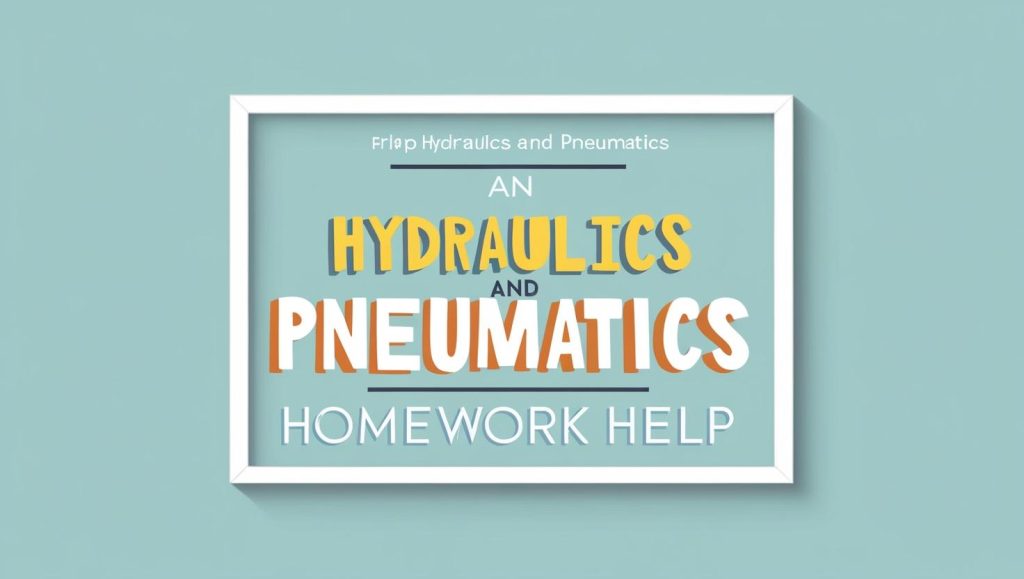Introduction: Why Hydraulics and Pneumatics Homework Help is Essential
Hydraulics and pneumatics are two crucial branches of fluid power engineering used in industrial, automotive, and aerospace applications. While hydraulics deals with the mechanical properties of liquids, pneumatics focuses on compressed air or gases.
Students studying these topics often encounter complex assignments related to Pascal’s Law, Bernoulli’s Principle, actuators, compressors, and control valves. This Hydraulics and Pneumatics Homework Help guide provides a structured approach to understanding these concepts, solving homework problems, and improving your academic performance.

What Are Hydraulics and Pneumatics?
Hydraulics and pneumatics are both used to transmit power and perform mechanical work but differ in the medium they use:
- Hydraulics: Uses pressurized liquids (typically oil or water) to generate force. Commonly used in heavy machinery, aircraft landing gear, and industrial presses.
- Pneumatics: Uses compressed gases (such as air or nitrogen) for automation, robotics, and lightweight machinery.
Understanding these systems is essential for students in mechanical, aerospace, and industrial engineering fields.
Key Principles in Hydraulics and Pneumatics
1. Pascal’s Law (Hydraulics)
Pascal’s Law states that when pressure is applied to a confined fluid, it is transmitted equally in all directions. Mathematically, it is expressed as: P=FAP = \frac{F}{A}P=AF
Where:
- PPP = Pressure (Pa)
- FFF = Force (N)
- AAA = Area (m²)
📌 Example Problem: A hydraulic press has a small piston with an area of 0.01 m² and a large piston with an area of 0.5 m². If a force of 100 N is applied to the small piston, what is the force exerted by the large piston?
✅ Solution: Using Pascal’s Law: F1A1=F2A2\frac{F_1}{A_1} = \frac{F_2}{A_2}A1F1=A2F2 1000.01=F20.5\frac{100}{0.01} = \frac{F_2}{0.5}0.01100=0.5F2 F2=5000NF_2 = 5000 NF2=5000N
Thus, the hydraulic system amplifies the input force to 5000 N!
✅ External Resource: Engineering Toolbox – Pascal’s Law
2. Bernoulli’s Principle (Pneumatics & Hydraulics)
Bernoulli’s Principle states that an increase in the speed of a fluid occurs simultaneously with a decrease in pressure. The Bernoulli equation is: P1+12ρv12+ρgh1=P2+12ρv22+ρgh2P_1 + \frac{1}{2} \rho v_1^2 + \rho g h_1 = P_2 + \frac{1}{2} \rho v_2^2 + \rho g h_2P1+21ρv12+ρgh1=P2+21ρv22+ρgh2
Where:
- PPP = Pressure
- ρ\rhoρ = Density
- vvv = Velocity
- ggg = Acceleration due to gravity
- hhh = Height
📌 Example Problem: A pipeline narrows from 0.5 m² to 0.2 m², increasing velocity from 2 m/s to 5 m/s. Find the pressure difference.
✅ Solution:
Using Bernoulli’s equation and assuming equal height levels: P1+12ρ(2)2=P2+12ρ(5)2P_1 + \frac{1}{2} \rho (2)^2 = P_2 + \frac{1}{2} \rho (5)^2P1+21ρ(2)2=P2+21ρ(5)2 P1−P2=12ρ(25−4)P_1 – P_2 = \frac{1}{2} \rho (25 – 4)P1−P2=21ρ(25−4)
Thus, pressure at the narrower section is lower.
✅ External Resource: Khan Academy – Bernoulli’s Principle
Hydraulic Systems: Components and Functions
A hydraulic system consists of:
- Hydraulic Pump – Converts mechanical energy into fluid energy.
- Control Valves – Regulate fluid flow and pressure.
- Actuators (Cylinders & Motors) – Convert hydraulic energy into mechanical work.
- Reservoir – Stores the hydraulic fluid.
- Filters – Remove contaminants from the fluid.
📌 Common Homework Problems:
- Designing a hydraulic lifting system.
- Calculating the pressure required for a hydraulic brake system.
✅ External Resource: Hydraulic System Basics
Pneumatic Systems: Components and Applications
A pneumatic system typically includes:
- Air Compressor – Compresses atmospheric air.
- Pressure Regulator – Maintains steady pressure.
- Directional Control Valves – Control airflow direction.
- Actuators (Pneumatic Cylinders) – Perform mechanical work.
- Pipes & Tubes – Transport compressed air.
📌 Common Homework Problems:
- Calculating airflow in a pneumatic system.
- Determining the force exerted by a pneumatic cylinder.
✅ External Resource: Pneumatic Systems – MIT OpenCourseWare
Common Hydraulics and Pneumatics Homework Problems and Solutions
Problem 1: Force in a Pneumatic Cylinder
Question: A pneumatic cylinder has a piston diameter of 0.1 m and operates at 500 kPa pressure. Find the force it generates.
✅ Solution: F=P×AF = P \times AF=P×A F=(500,000)×(π(0.05)2)F = (500,000) \times (\pi (0.05)^2)F=(500,000)×(π(0.05)2) F≈3927NF \approx 3927 NF≈3927N
Thus, the cylinder exerts 3927 N of force.
Problem 2: Hydraulic Power Calculation
Question: A hydraulic pump delivers 0.02 m³/s at 10 MPa. Find the power output.
✅ Solution: P=Q×PP = Q \times PP=Q×P P=(0.02)×(10×106)P = (0.02) \times (10 \times 10^6)P=(0.02)×(10×106) P=200kWP = 200 kWP=200kW
The hydraulic system delivers 200 kW of power.
How to Approach Hydraulics and Pneumatics Homework Effectively
- Understand Fundamental Equations: Learn Pascal’s Law, Bernoulli’s Principle, and force calculations.
- Break Down Complex Problems: Identify given values, required outputs, and applicable formulas.
- Use Online Tools: Websites like Coursera offer free hydraulics courses.
- Practice Regularly: Solve numerical problems frequently.
- Seek Professional Help: Services like Chegg provide expert tutoring.
Additional Resources for Hydraulics and Pneumatics Homework Help
Conclusion: Mastering Hydraulics and Pneumatics Homework
By understanding key principles and practicing problems, you can excel in hydraulics and pneumatics. This Hydraulics and Pneumatics Homework Help guide provides the necessary knowledge to tackle assignments confidently.


